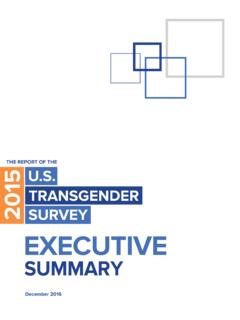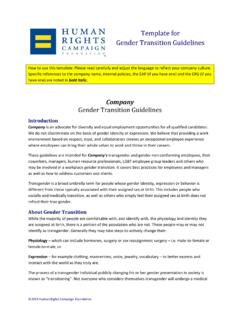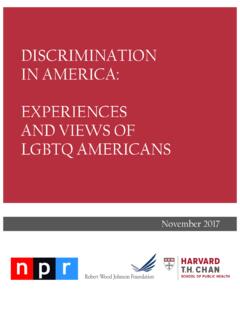Transcription of What’s Your Pronoun? - Out & Equal | Workplace Advocates
1 what s your Pronoun? Strategies for Inclusion in the WorkplaceCan everyone do a quick round of introductions with your name, job title, and pronouns ?As recently as the last few years, this request would be rare, if occurring at all, in most workplaces. As more companies invest in LGBTQ inclusion and gender-inclusive workplaces, pronouns have become a significant focal point. From pronouns listed on email signatures and business cards to pronoun buttons worn by retail employees, the business community has quickly embraced these practices. The following guide supports employers understanding of the intersection of daily communications, pronoun usage, gender identity, and expression at work, as well as practical strategies for use is so embedded throughout everyday interactions, it is easy to take for granted how much we rely on signals and assumptions for statements such as the following:The meeting with Mr.
2 Gonzalez is at 10:00am. He requested time with the entire s application looks great. Could we set up an interview with her next week?Pete was right when he said the client would ask for more time on this the phone, in-person, over email pronoun references like these and others permeate our everyday conversations. In addition, many people fall back on gendered language to express respect, formality, and/or convey a customer friendly tone:Ladies and gentlemen, welcome aboard and thank you for flying with us this , did you want to see this phone or the newer model?Ma am, I can help you at this most people are well-intentioned in such interactions, making the wrong assumption about someone s gender identity or expression, and, by extension their pronouns , can be insulting, harmful, and, if done repeatedly, constitute Workplace bias or harassment. Note that in this previous sentence, the word their was used to articulate a hypothetical person without assuming gender.
3 In 2019, Merriam-Webster added the singular use of the pronoun they to its dictionary to acknowledge the increased adoption of the word by the non-binary community. In 2019, the dictionary named they as its word of the year after internet searches for the term rose by 313% from the previous year (Locker, 2019).While the non-binary community s embrace of they is a relatively newer concept, the use of they in singular form is not. In fact, they has been used in singular form for over 600 years because the English language famously lacks a gender-neutral singular pronoun to correspond neatly with singular pronouns like everyone or someone (Locker, 2019). Much like our individual names, pronouns are tied to our deepest sense of identity. They articulate who we are and how the outside world should recognize and address us. Consider the feeling you encounter when someone calls you by the wrong name despite having introduced oneself.
4 In this situation, most of us are often racked with a sense of invalidation: Didn t I tell them my name already? Why did they forget? Did they not care enough to know me? Unfortunately, many of those who know the importance of correct pronoun usage are often those who have most experienced the pain and discomfort associated with being misgendered. Utilizing inclusive pronoun practices in the Workplace is vital in building organizational cultures of respect and belonging not just for the LGBTQ community, but for anyone who in some way challenges the traditional model of gender identity and culture that utilizes inclusive pronoun practices also supports a wide cross-section of employees and customers. Respectfully introducing pronouns is vital for the CFO who is a cisgender woman, but constantly misgendered over the phone because of her low voice. It is vital for the feminine presenting cisgender male flight attendant who is tired of being referred to as ma am.
5 It is vital for increased global cultural competency when interacting with employees or clients in different countries or employees who are non-native speakers and unfamiliar with traditionally gendered may not always be obvious how an employer can successfully implement practices and norms around pronouns to facilitate greater inclusion. This guide has been designed with that in mind and articulates specific, practical guidance on how to implement more inclusive practices and procedures regarding pronouns in the : One Piece of the Workplace Culture Puzzle. Companies should take careful consideration to ensure that foundational standards of LGBTQ and gender Workplace inclusion are implemented in addition to the policies and practices outlined in this document inclusive non-discrimination policies and LGBTQ 101 training being two important first steps. See Out & Equal s 20 Steps to an Out & Equal Workplace for guidance.
6 The recommendations outlined in this document are best coupled with educational efforts to cultivate an organizational culture that is inclusive of transgender /Gender Non-Conforming (GNC) individuals so as not to inadvertently expose these employees to uncomfortable and hostile situations. In other words, do not operationalize practices around pronouns if your company does not have fundamental support systems in place to protect and support its transgender /GNC research demonstrates a clear imperative for implementing inclusive pronoun practices in the Workplace . Demographic trends illustrate new and accepting perceptions of gender identity and expression, particularly in younger Imperative for Inclusion Now 1 Gender is More Expansive than Ever Before. In the US today, there are an estimated million transgender Americans, and one in three adults (ages 18-29) know someone who uses gender-neutral pronouns (Geiger & Graf, 2019).
7 Notably, nearly half of Americans now see gender on a spectrum and feel comfortable using gender-neutral pronouns , figures which are expected to continue to rise (Sosin, 2020; The Harris Poll, 2018). Millennials now represent the largest share of the US labor force a generation notorious for its open-mindedness, inclusive values, and higher rates of LGBTQ identity while members of Generation Z enter adulthood and are poised to be the most diverse and gender-fluid generation yet (Cilluffo & Cohn, 2019). One in three adults (ages 18-29) know someone who uses gender-neutral pronouns .(Geiger & Graf, 2019)Nearly half of Americans now see gender on a spectrum and feel comfortable using gender-neutral pronouns .(Sosin, 2020; The Harris Poll, 2018)42 Employees Seek Gender-Inclusive Practices. A majority of Americans now support gender-inclusivity in the Workplace . Pew Research demonstrates that 59% of Gen Zers believe that forms and/or online profiles should include gender options outside of man or woman.
8 A 2018 Harris Poll survey commissioned by Out & Equal and Witeck Communications found that 74% of respondents believe that employers should learn and use employees pronouns and chosen* name in the Workplace . Furthermore, 65% of respondents agree that employers should intervene when an employee regularly misuses a co-worker s pronouns or chosen name, while 58% believe that regular misuse is a form of Workplace harassment (The Harris Poll, 2018).3 Inclusivity Improves Business and Inclusive Pronoun Practices Are Key. As a whole, LGBTQ inclusivity boosts business outcomes. Research consistently demonstrates that LGBTQ-inclusive Workplace environments generate increased performance, productivity, retention, talent, and well-being (The Human Rights Campaign, 2014). Furthermore, LGBTQ-supportive policies are associated with higher company value, productivity, and profitability.
9 Younger generations actively seek employment at companies that share their own values of inclusion and facilitate connected cultures of belonging (Johansson, 2017).In addition, an increasingly global workforce is calling for new tools to ensure tenants of respect and cultural competency are built into everyday interaction. Incorporating and normalizing practices to identify pronouns in the Workplace is both critical for LGBTQ inclusion and can be helpful in instances of cross-cultural communication where pronouns are less apparent.*Many transgender /GNC individuals choose to go by a name that is different than the name given to them at birth. A chosen name may be different than the name indicated on official of respondents agree that employers should intervene when an employee regularly misuses a co-worker s pronouns or chosen Matter. Using someone s proper pronouns makes a difference in the mental health and well-being of everyone, particularly transgender /GNC individuals.
10 When a transgender /GNC person is misgendered, it adds to the variety of challenges they may regularly encounter. It can cause a range of difficult feelings, including dysphoria, anxiety, stigmatization, lowered self-esteem, and embarrassment, to name a few. Gender-affirmative support can have a powerful, if not lifesaving, impact. In the Workplace , for example, transgender individuals with supportive coworkers and work environments demonstrate lower rates of suicide thoughts and attempts in recent studies (Herman, Brown & Haas, 2019). Furthermore, studies also demonstrate that gender-affirmative support can also reduce depression, improve self-esteem, and create a better quality of life for transgender /GNC individuals (Temkin & Vega, 2020). Using an individual s correct pronouns is a powerful affirmation of self for transgender /GNC individuals. It validates one s identity, encourages authenticity, and builds truly inclusive and supportive cultures.







